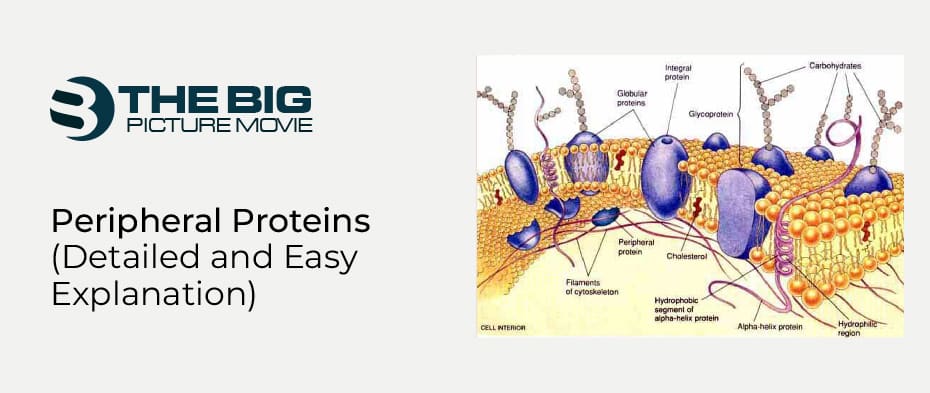
Peripheral Proteins (Detailed and Easy Explanation)
As the word “Peripheral Protein” suggests a close association with the cell membrane and cellular components, I hereby intend to illustrate its composition and how it works in coordination with the cell membrane. The cell membrane acts like a protective shield that curtails the forbidden particle from entering the cellular structure. The function of peripheral proteins is always in support of the cell membrane shield and protection. Thus, it is easy to learn about Peripheral Proteins or the types of studies and health concerns that surround them.
Introduction to Peripherals Proteins
Before getting into the details, the word peripheral describes the comprehensive framework for the plasma membrane with attached integral proteins. The role of the plasma membrane, therefore, corresponds well to limiting and protecting the cell from the environment.
The lipid bilayer is the barrier of the cell membrane. A group of molecules of Amino acids connects with the lipid bilayer of cell membranes is peripheral proteins. Another name is peripheral membrane proteins. But there is a slight difference that peripheral exists on the inside or outside the surface of phospholipids bilayer through a hydrogen bond. In contrast, the peripheral membrane enters the bilayer. It does not enter a cell membrane through the hydrophobic gap like integral membrane proteins. Instead, having a specific chain of amino acids attracts the phosphate heads of lipid molecules or essential proteins.
It does not lock on the cell membrane surface. And it involves different biochemical pathways also. There are several ways of activating or disabling it.
Structure of Peripheral Proteins
A peripheral protein has several characteristics which resemble it. It does not have a specific shape. Firstly, all these proteins link with the cell membrane. The amino acid chains of these proteins are different, assembled with the surface of the membrane. These chains support designated action This type of protein is attached to the phosphoglyceride lipid molecules which means lipid bilayer or integral proteins. Lack of protein in amino acids will not bind with membranes, and it is not peripheral proteins as it evenly distributes throughout the cytoplasm.
Secondly, it does not have an amino acid hydrophobic region. This protein will make the polarity with other amino groups and peripheral proteins attached to the surface of the cell membrane. It is because of the amphipathic behavior of phosphoglyceride. It indicates that the polar region is the blue head and hydrophilic. And tails show the center or middle of the membrane, which is hydrophobic. Often, these proteins have many hydrophilic amino acids not to have been gasp by the cell membrane. While Hydrophilic amino acids uncover water and in the middle integral proteins discover hydrophobic amino acids. It makes the lock within the membrane completely.
Functions of Peripheral Proteins
The functions of such proteins are based on these terms:
- Support
- Enzymes
- Molecule Transfer
- Communication
Supported characteristics of Peripheral Proteins
The most crucial role of this protein is the structure of the cytoskeleton and extracellular matrix components. A series makes these structures of filaments, tubules, and organelles. These structures need something to attach as they produce rigidness or stretching. At this point, it connects with the cell membrane. Mainly, it has the characteristics to control the shapes and sizes of the cytoskeleton and extracellular matrix used in many cell methods. The cytoskeleton can move around metabolism, separated from several peripheral proteins. A fresh protein packet may carry through cytosol using a cytoskeleton in the Golgi apparatus. A specific peripheral protein starts getting rid of the cell membrane on recognizing the package.
Peripheral Proteins with Enzymes
The combination or to break with other molecules, peripheral protein is present on the surface of the cell membrane to perform specific substrates. Various enzymes that control the synthesis and destruction are also proteins of the cell membrane because simple enzymes function with these proteins, making molecules close to the cell membrane.
Peripheral Proteins as Molecule Transfer
Due to the closeness with the cell membrane, it allows staying in a tight space. Moving function energizes glycolysis products’ breakdown into ATP or accessible molecules. These proteins transfer the electron or small molecules like a driver in the car. Mostly, these proteins are present with an electron transfer chain to transfer electrons from integral proteins attached with it and pass them to other proteins or molecules. In contrast, other molecules like hydrophobic bound with such proteins pass through various methods across the membrane.
Communication among Cells
Apart from structural support, the extracellular matrix also plays a role in gathering knowledge from other cells. In starting bacteria, the chain of reactions with the filaments of the extracellular matrix energizes peripheral proteins. The passing message of these proteins inside the cell to integral proteins is eventually a response of another peripheral protein.
All these proteins and chemical signals make chained reactions to stimulate other organelles or DNA responses. In this manner, microscopic organisms or cells grow as multicellular organisms and stop growing at a specific time. Likewise, cells produce more or expose toxins based on the microenvironment signal that it receives. Additionally, it can attach or detach from the cell membrane based on some factors like pH or temperature. These characteristics allow the cell to make different tactics for different environments. Also, control the processes like cell signaling or hormone reception.
Conclusion
Sometimes it is difficult to understand any topic, especially science subjects. But thorough reading makes it easy to understand the issue. The explanation on peripheral proteins is worthy and informative; You can use animated videos or lectures.


![MEDDIC [A B2B Sales Methodology]](https://www.thebigpicturemovie.com/wp-content/uploads/2023/01/MEDDIC.jpg)
